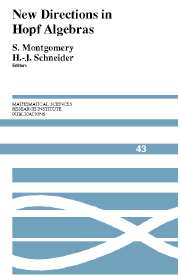Book contents
- Frontmatter
- Contents
- Preface
- Pointed Hopf Algebras
- On the Classification of Finite-Dimensional Triangular Hopf Algebras
- Coideal Subalgebras and Quantum Symmetric Pairs
- Hopf Algebra Extensions and Cohomology
- Finite Quantum Groupoids and Their Applications
- On Quantum Algebras and Coalgebras, Oriented Quantum Algebras and Coalgebras, Invariants of 1-1 Tangles, Knots and Links
- Hopf Algebra Extensions and Monoidal Categories
- A Short Course on Quantum Matrices
- The Brauer Group of a Hopf Algebra
A Short Course on Quantum Matrices
Published online by Cambridge University Press: 25 June 2025
- Frontmatter
- Contents
- Preface
- Pointed Hopf Algebras
- On the Classification of Finite-Dimensional Triangular Hopf Algebras
- Coideal Subalgebras and Quantum Symmetric Pairs
- Hopf Algebra Extensions and Cohomology
- Finite Quantum Groupoids and Their Applications
- On Quantum Algebras and Coalgebras, Oriented Quantum Algebras and Coalgebras, Invariants of 1-1 Tangles, Knots and Links
- Hopf Algebra Extensions and Monoidal Categories
- A Short Course on Quantum Matrices
- The Brauer Group of a Hopf Algebra
Summary
Introduction
The notion of quantum matrices has interesting and important connections with various topics in mathematics such as quantum group theory, Hopf algebra theory, braided tensor categories, knot and link invariants, the Yang-Baxter equation, representation theory and so on.
This course is an introduction to quantum groups. I have made an effort to have the exposition as elementary as possible. I intended to talk in some informal way, and did not intend to give detailed proofs. The present notes have somewhat more formal and rigorous flavor than the actual lectures, in which I tried to visualize and illustrate connections with knot theory by using transparency sheets.
I begin with introducing 2x2 q-matrices in Section 1. They are characterized in two ways, one by the q-adjoint matrix (Proposition 1.3) and the other by the R-matrix Rq (Proposition 1.6). Each of them admits an interesting interpretation in the theory of knot invariants, and this is illustrated in Section 2 by talking about a basic knot invariant, called Kauffman's bracket polynomial.
The 2x2 q-matrices have the remarkable property that their n-th powers are qn-matrices. This fact was found around 1991 by several physicists. I reproduce Umeda and Wakayama's elegant proof in Section 3. The first characterization (Proposition 1.3) plays a role in the proof.
General q-matrices of degree n are introduced in Section 4 as well as a brief exposition of fundamental facts involving the R-matrix Rq, the q-symmetric and q-exterior algebras, the q-determinant, the q-adjoint matrix and so on.
Information
- Type
- Chapter
- Information
- New Directions in Hopf Algebras , pp. 383 - 436Publisher: Cambridge University PressPrint publication year: 2002
Accessibility standard: Unknown
- 1
- Cited by
